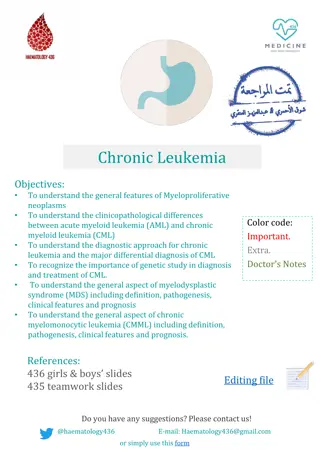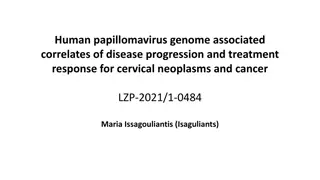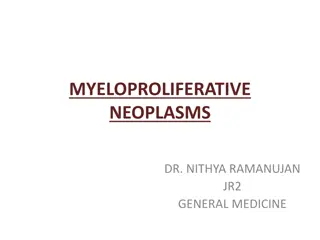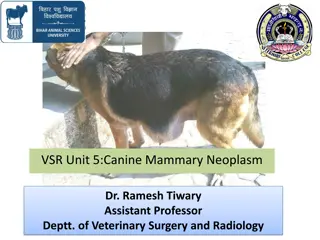Overview of Chronic Leukemia and Myeloproliferative Neoplasms
This comprehensive guide covers the general features, diagnostic approach, and clinicopathological variances between acute myeloid leukemia (AML) and chronic myeloid leukemia (CML), along with insights into myelodysplastic syndrome (MDS) and chronic myelomonocytic leukemia (CMML). It emphasizes the
1 views • 9 slides
Investigating Human Papillomavirus Genomes in Cervical Neoplasms
This project focuses on studying the Human Papillomavirus (HPV) genome's association with disease progression and treatment response in cervical neoplasms and cancer. The research aims to genotype high-risk HPVs in healthy and diseased cervix, identify prevalent genotypes, detect genotype drift, cha
1 views • 13 slides
Understanding Myeloproliferative Neoplasms: Overview and Clinical Considerations
Myeloproliferative neoplasms (MPNs) include a group of disorders characterized by overproduction of blood cells. The WHO classification outlines eight disorders with varied clinical presentations and potential for transformation. These disorders, such as CML, CNL, and PV, exhibit significant phenoty
2 views • 58 slides
Understanding Health Risk Adjustment Models in Healthcare
This content discusses the DHA Risk Adjustment Model, its clinical conditions, and the utilization of risk scores in various populations. It outlines how Health Affairs sponsored the development of a tailored risk adjustment model for the Prime Population and provides examples of clinical conditions
0 views • 23 slides
Comprehensive Overview of Parotid Tumor Diagnosis and Management
This comprehensive guide covers the diagnosis and management of parotid tumors, including anatomy, differential diagnosis, and management strategies. It discusses the approach to evaluating patients with neck lumps, differential diagnoses to consider, and the management techniques for both benign an
0 views • 20 slides
Organoid Models for Neuroendocrine Cell Growth and Tumorigenesis
Research presented at the ENETS 2020 virtual meeting discussed the generation of organoids from lung, intestinal, and pancreatic neuroendocrine neoplasms (NENs) to study normal neuroendocrine cells and their transformation to NENs. The success rate in generating organoids was higher for lung NENs co
0 views • 20 slides
Schedule of Ratings for Skin Conditions in CFR 38.4.118
This document outlines the Schedule of Ratings for various skin conditions, including burn scars, dermatitis, leishmaniasis, lupus, tuberculosis luposa, dermatophytosis, bullous disorders, skin neoplasms, infections, collagen-vascular diseases, and more. It provides detailed descriptions and classif
0 views • 16 slides
Pediatric & AYA MPN: Understanding Young Patients with Myeloproliferative Neoplasms
Exploring the landscape of Myeloproliferative Neoplasms (MPNs) in young patients, focusing on the age distribution, disease prevalence, and unique characteristics like triple negative ET. Presenter: Dr. Nicole Kucine from Weill Cornell Medicine provides insights and raises important questions for fu
0 views • 21 slides
Understanding HIV: Transmission, Symptoms, and Management
HIV, a single-stranded, positive-sense, enveloped RNA retrovirus, is transmitted through various means such as sexual intercourse, vertical transmission, and blood contact. The virus targets T cells, macrophages, and other immune cells, leading to acute and chronic stages with distinct symptoms. As
0 views • 37 slides
Histiocytic Neoplasia in the Heart: A Rare Case Report
A 3-year-old girl presented with persistent fever, leading to the discovery of a cardiac mass diagnosed as histiocytic neoplasia through imaging and biopsy. Primary cardiac tumors are rare in children, with benign tumors being more common. Histiocytic sarcomas are malignant neoplasms with characteri
0 views • 10 slides
Canine Mammary Neoplasms: Overview and Management by Dr. Ramesh Tiwary
Canine mammary neoplasms, including benign adenomas and malignant carcinomas, are common in intact female dogs. This article discusses the clinical signs, diagnosis methods like FNAC and biopsy, WHO clinical staging system, and the importance of palpating regional lymph nodes for prognosis assessmen
0 views • 15 slides
Understanding Brain Tumors: Classification, Clinical Features & Prognosis
Brain tumors, whether primary or secondary, present with various clinical features such as neurological deficits, seizures, and raised intracranial pressure. The classification includes common types like gliomas, meningiomas, and medulloblastomas. Astrocytomas are the most common primary intracrania
0 views • 22 slides
Understanding Pyrexia of Unknown Origin: Causes and Classification
Pyrexia of unknown origin (PUO) is a challenging diagnostic scenario characterized by persistent fever without an identified cause. Dr. Sujeetha Chandrababu M.D. defined PUO as temperatures exceeding 38.3°C for several weeks with no definitive diagnosis. Classification of PUO includes various categ
0 views • 43 slides
Understanding Polycythemia Vera: Causes, Symptoms, and Classification
Polycythemia vera is a chronic myeloproliferative disorder characterized by increased red blood cell production due to JAK2 mutations. Learn about its classification, pathogenesis, morphology, and key differences from secondary polycythemia. Early diagnosis and management are crucial to prevent comp
0 views • 41 slides
Overview of Pharyngitis: Symptoms, Causes, and Classification
Pharyngitis is characterized by sore throat, categorized as acute or chronic. Acute pharyngitis has a sudden onset, while chronic pharyngitis persists longer. Chronic types include hypertrophic, atrophic, and granular, each with specific characteristics. Majority of cases are viral, with streptococc
1 views • 16 slides
Durvalumab Plus Tremelimumab in Advanced Neuroendocrine Neoplasms: The DUNE Trial at ESMO 2020
A multi-cohort phase 2 study presented at ESMO 2020 evaluated the combination of durvalumab and tremelimumab in patients with advanced neuroendocrine neoplasms. The DUNE trial assessed the efficacy of this immunotherapy approach in various neuroendocrine tumor types, emphasizing the potential benefi
0 views • 17 slides















